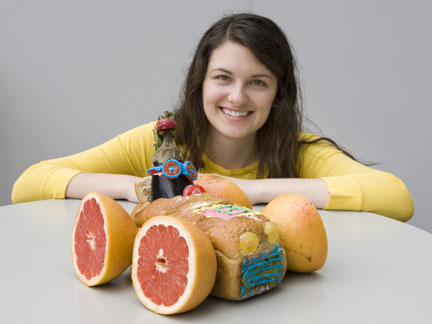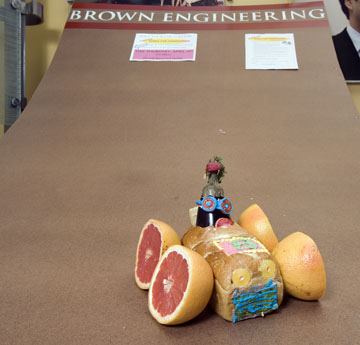
|
April 8, 2008 |
Division of Edible Engineering
Fast Food? Brown Students Make and Race Edible Cars
Brown University engineering students have organized the campus’s first Edible Car Competition, in which teams build and race vehicles made out of food – with materials ranging from bagels to butternut squash. | |||
|
Brown University Home |
PROVIDENCE, R.I. [Brown University] — Does a zucchini travel faster than a butternut squash? Do pretzels work better as axles than fettuccini? Do bagels roll more smoothly than rice cakes? It’s not about the taste of food at the first-ever Edible Car Competition being held at Brown University April 10, 2008; it’s about building the best-looking – and most mobile – vehicle out of the stuff we eat.  Little Fruit Coupe The competition, organized by students in Brown’s Division of Engineering, will test participants’ ability to build a vehicle out of everyday foods ranging from carrots to cookies. About a dozen teams will then “race” their vehicles to determine which travels the farthest – and learn which aren’t road-worthy. A panel of judges that includes Brown engineering faculty, administrators, and the University’s executive chef will declare a winner based on a vehicle’s appearance and the distance it travels. The contest begins at 4 p.m. and takes place on Manning Walk, which sits off Brook Street outside the Barus and Holley building on the main campus. Teams have an hour to construct their edible vehicles. The distance challenge is scheduled to begin at 5 p.m. The contest idea came from Julie Sygiel, a Brown junior and chemical engineering concentrator. Sygiel competed in similar contests as a middle school student in Kentucky – learning through trial and error that, for example, rice cakes were a better choice than donuts for wheels. At Brown, she and members of the Xtreme Special Events Committee wanted to stage a competition that would be fun and build ties between engineering students and the Brown community.  Downhill All the Way Contestants will build their vehicles by choosing eight items from the following foodstuffs: bagels, butternut squash, carrots, eggplant, potatoes, pretzels, rice cakes, and zucchini. They also can make their vehicles more functional or dress them up by choosing ingredients such as gum drops, marshmallows, peanut butter and strawberry icing. Teams also can bring their own parts, so long as they are edible. The engineering students have built a ramp measuring three–and-a-half feet high – with “a lot of speed potential,” they say – on which the edible vehicles will be placed and then released, careening downhill and measured to the point on the walkway at which they stop, flip over, or fall apart – whichever comes first. “We wanted something that would be entertaining,” Sygiel said. “And it’s going to look funny,” added fellow organizer Sara Glick, a sophomore and computer engineering concentrator. Organizers will place checkered flags along Manning Walk along with an edible “Victory Arch.” “It’s going to be a good spectator sport,” Glick said. Greg Crawford, dean of the Division of Engineering, said the competition pushes students’ creativity to the limit. “By utilizing unusual materials to design a simple vehicle, the students will apply basic concepts of design and dynamics they have learned in the classroom,” Crawford said. The Division of Engineering is the oldest undergraduate engineering program in the Ivy League and the third oldest civilian engineering program in the country. The division serves more than 400 undergraduates yearly, taught by more than 40 professors. Editors: Brown University has a fiber link television studio available for domestic and international live and taped interviews and maintains an ISDN line for radio interviews. For more information, call the Office of Media Relations at (401) 863-2476. ###### | |||